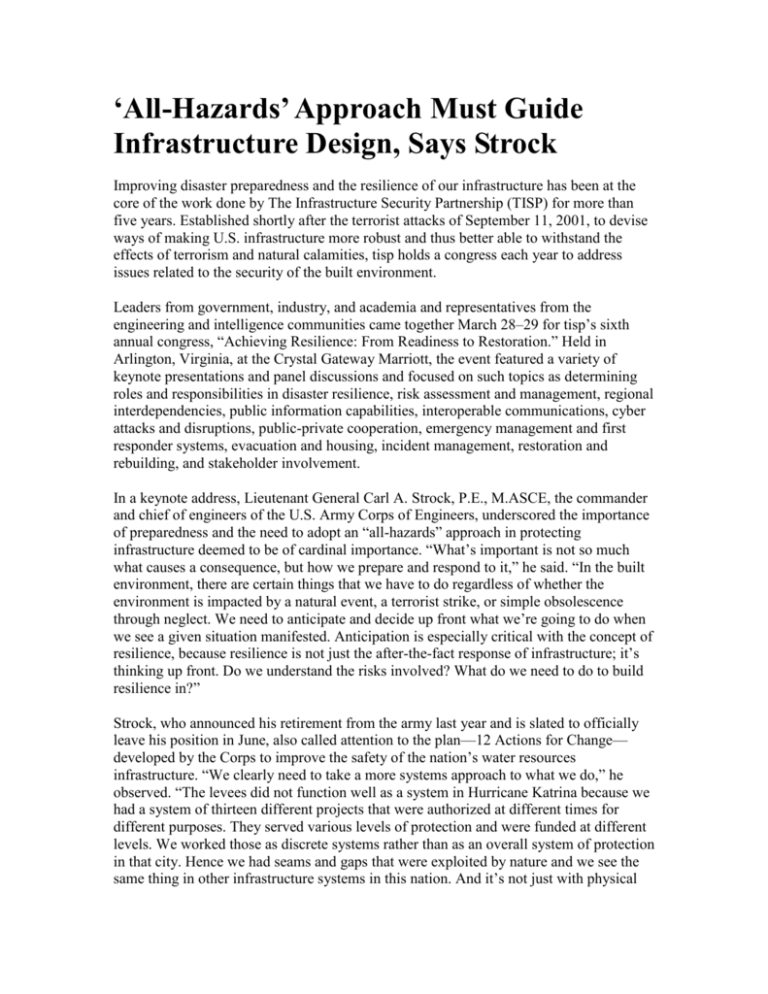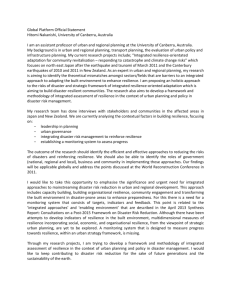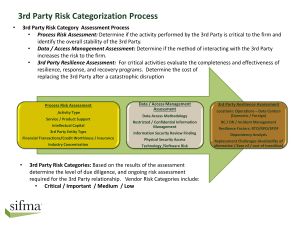
‘All-Hazards’ Approach Must Guide
Infrastructure Design, Says Strock
Improving disaster preparedness and the resilience of our infrastructure has been at the
core of the work done by The Infrastructure Security Partnership (TISP) for more than
five years. Established shortly after the terrorist attacks of September 11, 2001, to devise
ways of making U.S. infrastructure more robust and thus better able to withstand the
effects of terrorism and natural calamities, tisp holds a congress each year to address
issues related to the security of the built environment.
Leaders from government, industry, and academia and representatives from the
engineering and intelligence communities came together March 28–29 for tisp’s sixth
annual congress, “Achieving Resilience: From Readiness to Restoration.” Held in
Arlington, Virginia, at the Crystal Gateway Marriott, the event featured a variety of
keynote presentations and panel discussions and focused on such topics as determining
roles and responsibilities in disaster resilience, risk assessment and management, regional
interdependencies, public information capabilities, interoperable communications, cyber
attacks and disruptions, public-private cooperation, emergency management and first
responder systems, evacuation and housing, incident management, restoration and
rebuilding, and stakeholder involvement.
In a keynote address, Lieutenant General Carl A. Strock, P.E., M.ASCE, the commander
and chief of engineers of the U.S. Army Corps of Engineers, underscored the importance
of preparedness and the need to adopt an “all-hazards” approach in protecting
infrastructure deemed to be of cardinal importance. “What’s important is not so much
what causes a consequence, but how we prepare and respond to it,” he said. “In the built
environment, there are certain things that we have to do regardless of whether the
environment is impacted by a natural event, a terrorist strike, or simple obsolescence
through neglect. We need to anticipate and decide up front what we’re going to do when
we see a given situation manifested. Anticipation is especially critical with the concept of
resilience, because resilience is not just the after-the-fact response of infrastructure; it’s
thinking up front. Do we understand the risks involved? What do we need to do to build
resilience in?”
Strock, who announced his retirement from the army last year and is slated to officially
leave his position in June, also called attention to the plan—12 Actions for Change—
developed by the Corps to improve the safety of the nation’s water resources
infrastructure. “We clearly need to take a more systems approach to what we do,” he
observed. “The levees did not function well as a system in Hurricane Katrina because we
had a system of thirteen different projects that were authorized at different times for
different purposes. They served various levels of protection and were funded at different
levels. We worked those as discrete systems rather than as an overall system of protection
in that city. Hence we had seams and gaps that were exploited by nature and we see the
same thing in other infrastructure systems in this nation. And it’s not just with physical
systems. It’s the economic systems of this country that we must also be thinking about—
the cyber systems, the information networks, and so on.”
Developed in a collaborative effort that drew on the expertise of the Interagency
Performance Evaluation Task Force (IPET)—the body set up by the Corps to evaluate the
performance of the hurricane protection system in New Orleans and southeastern
Louisiana during Katrina—asce, the National Science Foundation, and Louisiana State
University, the plan comes in response to the need for the Corps to comprehensively
design, construct, maintain, and update systems so that they will be sufficiently robust
and will benefit from full stakeholder participation. It also reflects the Corps’s resolve to
improve communication both internally and with the public and to advance public service
professionalism.
Strock, who signed and released the plan on August 24, 2006, expatiated on the Corps’s
commitment to risk assessment and disclosure. “We really need to focus on risk
communication,” he said. “We want to contribute to informed decision making and make
sure the public servants in this country are national decision makers and [that] individual
citizens are also aware of the risks they face so that they can make informed decisions.
This is not an easy task because we deal with very complex issues. But we have to have
an open and honest dialogue, and the challenge for us is to do it in a clear and simple
way. We’ve got to strike a balance between the need for information security and
transparency.”
The steps outlined in the Corps’s plan include adopting an integrated, comprehensive,
and systems-based approach; applying risk-based concepts in planning, design,
construction, operations, and major maintenance; and continuously reassessing and
updating policy as it relates to program development, planning guidance, and design and
construction standards. Moreover, the Corps intends to avail itself of the advantages
conferred by dynamic independent review; to employ adaptive planning and engineering
systems; to focus on sustainability; to review and inspect completed works; to assess and
modify its organizational behavior; to effectively communicate risk and develop risk
reduction strategies that involve the public; to manage and enhance technical expertise
and professionalism; and to invest in research.
“This nation is still the strongest in the world and many people look to us for leadership
and assistance when they’re in trouble,” added Strock, who then cited Regional Disaster
Resilience: A Guide for Developing an Action Plan, a 36-page guidebook that tisp
published last June. “This is not an action plan,” he pointed out. “It is a guide for
developing an action plan, a thought piece on how to do it, and I think it’s a very good
one. It focuses on regional disaster resilience and it defines regions not just along
political boundaries but along systems boundaries that we need to be thinking about. It’s
also very consistent with the approach that’s been taken at the Department of Homeland
Security and the Federal Emergency Management Agency, which has shifted and
expanded to an all-hazards strategy.”
According to the guidebook, “regional public-private partnerships” are essential for
fostering information sharing and coordination and “should include all levels of
government, utilities, and other service providers.” Aimed at uncovering readiness gaps,
recommending solutions, and providing a benchmark for gauging a region’s level of
disaster resilience, the guide includes a detailed inventory of needs that have been
defined through infrastructure vulnerability assessments. It also highlights findings from
interdependency exercises and lessons that have been learned from major events,
including such natural disasters as Katrina and such man-made ones as the power
blackout that affected large swaths of the country in August 2003.
“I think we need to expand this effort beyond our own shores,” Strock said in closing. “It
is truly an interdependent world that we live in today. Things can happen overseas that
can influence us in this country, so we need to be prepared to carry abroad the
mechanisms that the tisp community has developed in thinking about the built
environment and responding when that environment is assaulted. The world’s ability to
respond to things like the [Indian Ocean tsunami] can be influenced by what we do in this
group. So I think we need to broaden our perspectives and expand this capacity
internationally.”
In a panel discussion that considered ways of incorporating interdependencies into risk
assessments, John Laws, a water and dam sector coordinator for the U.S. Department of
Homeland Security, addressed various complexities and challenges related to prioritizing
and protecting investments in both the public and private sectors. “Understanding the
interdependencies between all the sectors and all the nuances that go along with that at
the operational level is a very complex game,” he said. “It’s not easy. But we are
beginning to understand that there are systems-based sectors, such as water,
telecommunications, and electricity, that can influence national issues back and forth.
We’re just now beginning to understand how this complex mixture operates and
functions as a total paradigm and how we have to pay attention in terms of all-hazards
and disaster response.”
Paula L. Scalingi, Ph.D., M.ASCE, who moderated the discussion, stressed the
importance of achieving regional resilience and integrating risk strategies into the
planning and management of vital facets of infrastructure. “If you’re going to have
resilient infrastructures, you have to have resilient regions,” she said. “And you’re only
going to have resilient regions if you understand the vulnerabilities associated with
interdependencies and understand from a risk-based approach how you need to deal with
those interdependency-related vulnerabilities.”
Scalingi, who is the vice-chair of TISP and the president of the Scalingi Group, of
Vienna, Virginia, also stressed the need for partnerships and stakeholder collaboration.
“We really have to move a lot further and a lot faster in understanding the
interdependencies among not just our critical infrastructure but our essential service
providers and our communities,” she added. “Regional resilience and the resilience of our
infrastructure are directly dependent on understanding interdependencies, which is
dependent on public and private and other organizations partnering. But you can only
address those interdependencies and vulnerabilities if you have the data; and you can
only get the data through information sharing; and you will only have information
sharing among key stakeholders if you have collaboration and trust at the local and
regional levels.”
The following day Congressman Bennie G. Thompson (D-Mississippi), the chairman of
the House Committee on Homeland Security, delivered a keynote speech that addressed
various priorities and goals related to threat deterrence, vulnerability reduction, and
resilience. “We’re going to be implementing a one-hundred-percent screening process,”
he said. “In three years all of our large ports will have to have a process in place to screen
all cargo before it reaches our shores. In five years smaller ports will also have to have a
process in place that can effectively screen everything.”
With 39 years of continuous public service, Thompson is Mississippi’s longest-serving
African-American elected official. He explained how he has also been working on
legislation that would increase government spending on rail security. “For the most part,
we’re doing a robust job screening passengers at airports,” he noted. “But if you go from
here to New York on the train, you can take just about anything you want on board and
nobody will stop you. We need to do a better job with this. We’re spending about nine
dollars per passenger for screening purposes on aviation security but less than two cents
per passenger on rail security. So we’re trying to get some more money so we can beef
up security on our trains. Overall, we want those who travel, regardless of the mode of
transportation they choose, to feel confident that the security apparatus we have in place
will in most instances find bad things.”
In closing, Thompson acknowledged the challenges that will have to be met, and he
called on the TISP community to share its ideas with his committee. “In thinking about
resilience, we have to consider whether we are allowing things to become more difficult
than they need to be by not forcing people to work together,” he said. “We have to make
sure that cities, counties, states, and the federal government are all on the same page. But
we still can’t legislate human behavior. Even though we’ve required intelligence agencies
to share information with each other, we’ve found that, for the most part, everything still
operates on a need-to-know basis. We’re working on this. I think you, as an organization,
could help us do better. If you have ideas, please share them with us. We have no
reservations about receiving good ideas. We even give credit to Republicans who bring
good ideas. So I want you to feel very comfortable in bringing ideas to the table, because
when the terrorists come they won’t ask for church affiliation [and] they won’t ask for
party affiliation. They just want to harm Americans. And we, as Americans and people
working for the security of this nation, simply can’t let that happen.”
—Mark Fitzgerald
©2008 ASCE. All rights reserved. ASCE & American Society of Civil Engineers.
Registered in U.S. Patent & Trademark Office
ASCE Publications • 1801 Alexander Bell Dr. • Reston, VA 20191 1-800-548-ASCE
(2723)









